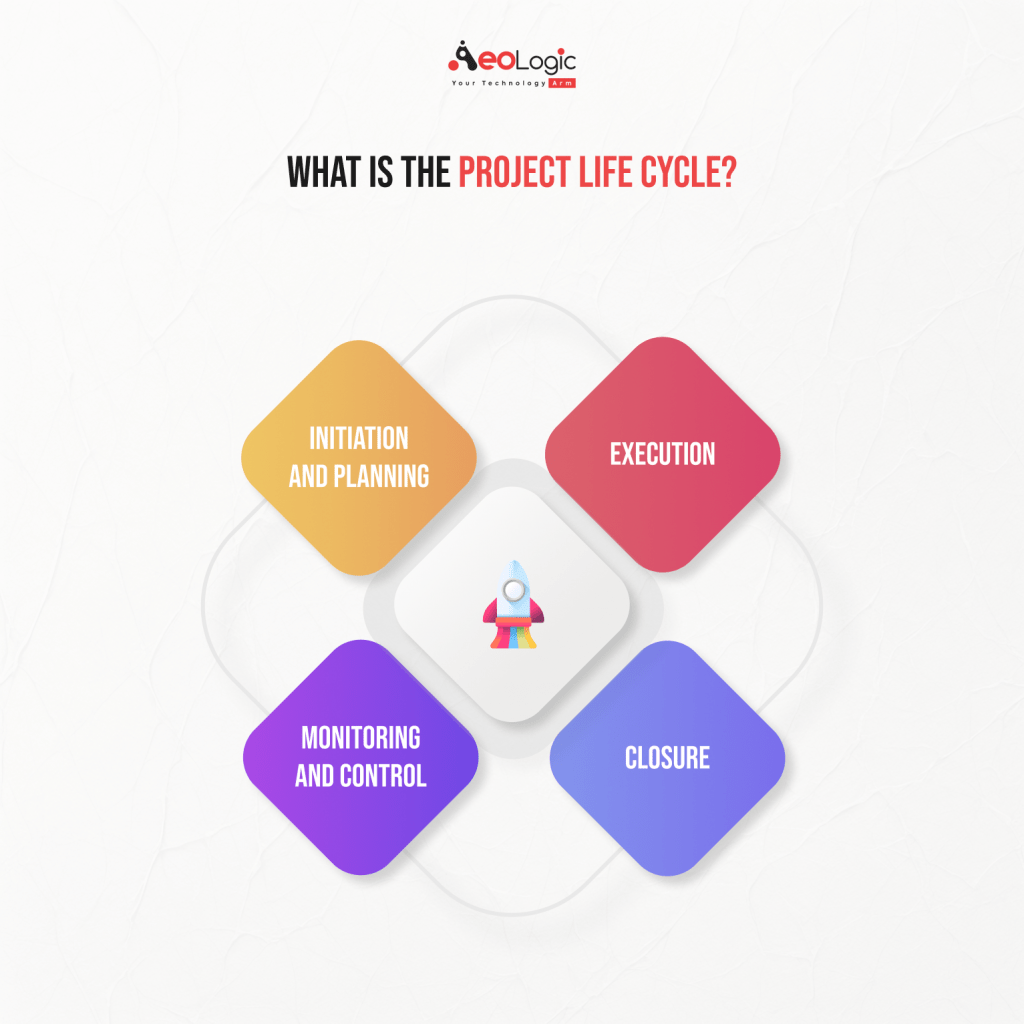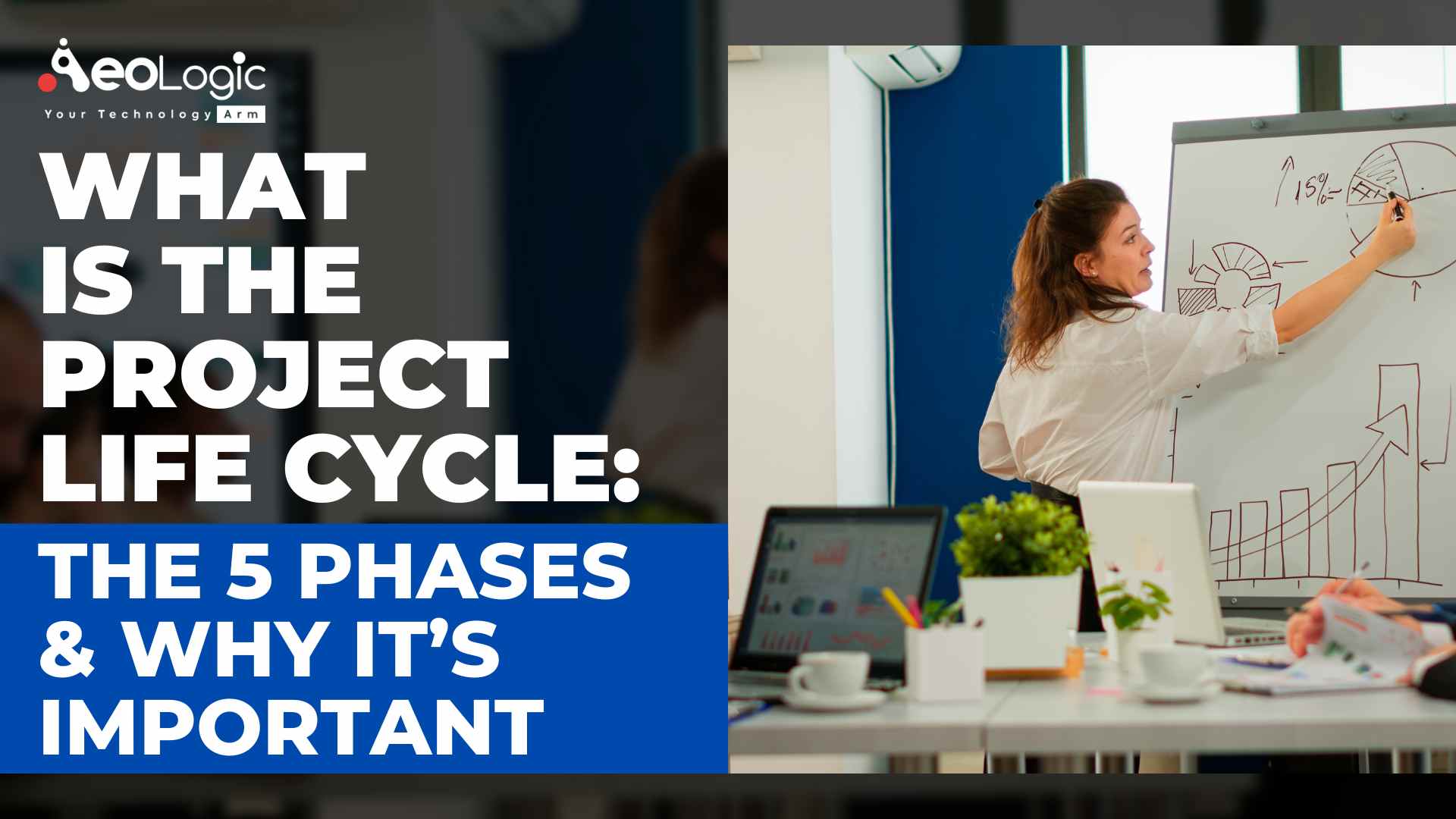The project life cycle is what you’ll use to manage the work on your project successfully. By using the right strategy, you can make sure that your project is developed and delivered in the most efficient way possible. In this article, we will discuss what each phase entails as well as what is the project life cycle: The 5 Phases & Why It’s Important?
Project management can be a difficult task. You need to understand the project life cycle and how it is an essential tool for the success of your project. There are many steps in the project life cycle.
Let’s Begin!
Table of contents
- What is the Project Life Cycle?
- Definition of each phase and how it relates to project management.
- The 5 phases: Initiation, Planning, Execution Monitoring, and control, Closure
- Why Is The Project Life Cycle Important?
- When Do you use the Project Life Cycle?
- Final Thought
Application development: Boost your business plans with customized applications.
What is the Project Life Cycle?

The project life cycle is a series of phases that a project goes through from start to finish.
The project life cycle typically includes the following phases:
- Initiation
- Planning
- Execution
- Monitoring and control
- Closure
Each phase of the project life cycle has its own set of activities and deliverables. The project manager is responsible for ensuring that the project moves through each phase in a timely and efficient manner.
The project life cycle is important because it provides a framework for managing a project from start to finish. It helps to ensure that all activities and deliverables are completed in a timely and efficient manner. It also helps to identify potential risks and issues early on, so that they can be addressed before they cause problems.
According to Wikipedia, “Project management is the discipline of initiating, planning, executing, controlling, and closing the work of a team to achieve specific goals and meet specific success criteria at the specified time.
Definition of each phase and How it Relates to Project Management
There are five main phases in the project life cycle: initiation, planning, execution, Monitoring, and closure. Each phase has its own distinct purpose and role in project management.
1. Initiation is the first phase of the project life cycle. During this phase, the project team is formed and the project objectives are established. This is also the phase where the project budget is set.
2. The planning phase is where the project plan is developed. This plan outlines how the project will be executed and includes all of the necessary tasks that need to be completed. The planning phase also includes risk assessment and management.
3. The execution phase is when the actual work of the project is carried out. This is where all of the tasks in the project plan are completed.
4. Measuring performance and keeping tabs on project development are at the heart of the monitoring and control phase. It is put into action as the process is being carried out. In this stage, you’ll want to make sure that your budget and schedule are consistent with the Project Management Plan.
5. The closure phase is when the project is officially completed and handed over to the client. This is also when the final report on the project is prepared.
Also Read: 10 Ways to Use Artificial Intelligence to Improve Business Processes
The 5 Phases: Initiation, Planning, Execution Monitoring and Control, Closure
The project life cycle is the process that a project goes through from start to finish. There are five phases of the project life cycle: Initiation, Planning, Execution Monitoring, and control, Closure.
Each phase has its own set of objectives and activities. The cycle is important because it helps to ensure that all aspects of the project are considered and that the project is completed successfully. Knowing about the five phases of the project life cycle is important because it helps you to plan your projects and make sure that you’re on track to finish them. They are:
#1. Initiation: First Phase of Project Life Cycle
The Initiation phase is the first stage of the project life cycle. This phase includes the identification of the need for the project and the development of a business case. The objectives of this phase are to define the scope of the project and to identify the stakeholders.
#2. Planning : Second Phase of Project Life Cycle
The planning phase is the second stage of the project life cycle. This phase includes the planning and execution of the project. The objectives of this phase are to develop a detailed plan for the project and to allocate resources.
#3. Execution: Third Phase of Project Life Cycle
The execution phase is the third stage of the project life cycle. Project execution is the process of implementing project-related procedures, assigning tasks, and allocating resources. The process also entails creating deliverables and meeting client expectations. Project managers or team leaders complete the assignment by allocating resources and keeping team members focused.
#4. Monitoring & Control: Forth Phase of Project Life Cycle
The monitoring phase is the fourth stage of the project life cycle. This is one of the most difficult aspects of the project management cycle. It entails performance reporting as well as project monitoring and management. This includes checking that the project is proceeding as planned, and if it isn’t, managing it by devising methods to bring it back on track. As a project manager, you will be monitoring and overseeing a project in some capacity at all stages of its life cycle.
#5. Closure: Fifth Phase of Project Life Cycle
The closure phase is the fifth and last stage of the project life cycle. With so much time and effort invested in project planning, it is easy to overlook the last step of the Project Management life cycle.
The project closure phase, sometimes known as the “follow-up” phase, is the final stage of the Project Management life cycle. The completed product is ready for delivery at about this time. The project manager and team should concentrate their efforts on product release and delivery. All project-related activities are completed at this point. The closing phase does not always follow a successful completion phase. Due to project failure, it is sometimes necessary to end a project.
Big Data & Analytics: Remodeling your raw technical data towards clear business information
Why Is The Project Life Cycle Important?
Knowing about the five phases of the project life cycle is super important because it allows you to be prepared for each phase of a project. For example, if you work in a business, knowing what it looks like when a company attempts to do something that they have never done before can be very helpful. Knowing what happens during each phase of the project life cycle will help you understand what might happen during a project, which can help you prepare for potential issues or problems.
You also need to know about the five different phases because they are important parts of many projects and businesses. This can help you understand how a team works together and how they communicate with one another throughout all stages of a project. Knowing about these five phases will also allow you to better understand why things happen as they do in any given situation.
Also Read: The Role of AI in Education And Learning: Just Promises Or Revolution
When Do you Use the Project Life Cycle?
The project life cycle is a framework that can be used to guide projects from start to finish. The Project Life Cycle helps to ensure that all aspects of a project are considered and that it is completed successfully. It provides a roadmap for projects so that everyone knows what needs to be done and when it needs to be done.
Every project follows the same basic steps: establishing goals, developing a strategy to achieve those goals, and putting that strategy into action. The phases of a project’s life cycle are generally consistent across projects, even if their names may vary significantly from one project manager or agency to the next.
The project life cycle offers project managers a route to follow as projects progress. At each step of the project, it specifies where to begin and where to move next. Whatever happens, you’ll have a dependable structure to return to and refocus on.
Also Read: The Role of AI in Education And Learning: Just Promises Or Revolution
Final Thought
There is no ideal approach to projecting the life cycle. However, by employing these phases, you may give your project a good framework and take the utmost care of each step. Furthermore, the project life cycle entails adhering to an established project management methodology that adheres to a set of common project stages with procedures that operate throughout each phase. Use project procedures with caution and remember to modify them as needed to meet the needs of the project. Make the most of prior project successes and mistakes, and use effective project management practices and the appropriate or mixed methodology to ensure a project’s seamless execution.
If you believe we have overlooked something, please leave a comment below!
You may quickly expand your company with the project management solutions. Ask for a free trial of Aeologic’s software and see how this software, the best option, can help your company expand.
Aeologic is a great place to start!
Also read: Trends in Sensor Technology and the Electric Vehicle Industry
Related Blogs:
- How AI/ML Can Change the Public Transportation Industry
- Transforming Business With Digital Technology in the Oil Palm Industry in India
- Importance of Digital Asset Management in the Retail Industry
- How AI is Transforming the Agriculture Industry
- 10 Ways to Use Artificial Intelligence to Improve Business Processes
- The Future of IoT Technology in Convenience Stores
- Building Manufacturing Resilience Through AI and ML









